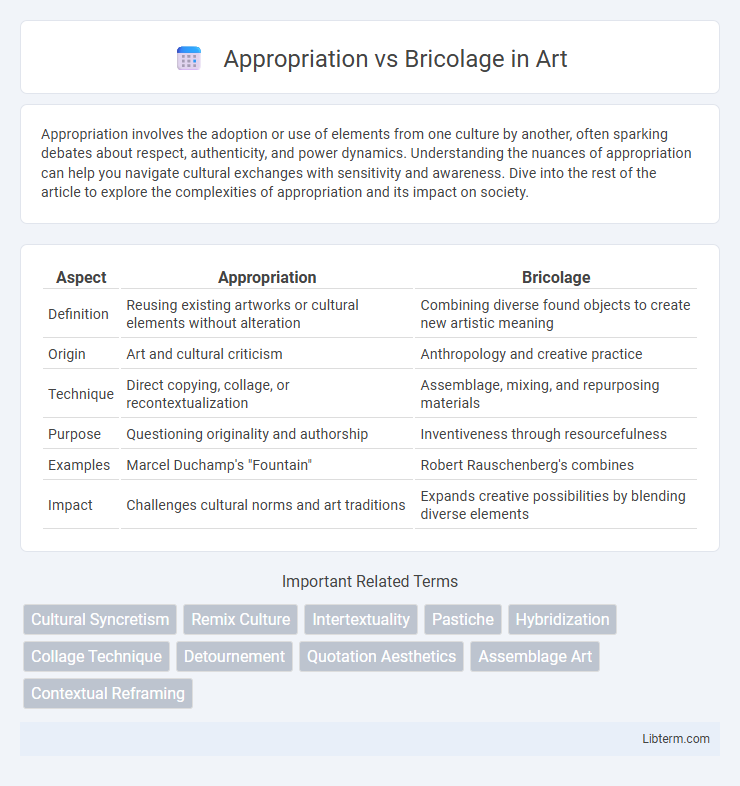Appropriation involves the adoption or use of elements from one culture by another, often sparking debates about respect, authenticity, and power dynamics. Understanding the nuances of appropriation can help you navigate cultural exchanges with sensitivity and awareness. Dive into the rest of the article to explore the complexities of appropriation and its impact on society.
Table of Comparison
| Aspect | Appropriation | Bricolage |
|---|---|---|
| Definition | Reusing existing artworks or cultural elements without alteration | Combining diverse found objects to create new artistic meaning |
| Origin | Art and cultural criticism | Anthropology and creative practice |
| Technique | Direct copying, collage, or recontextualization | Assemblage, mixing, and repurposing materials |
| Purpose | Questioning originality and authorship | Inventiveness through resourcefulness |
| Examples | Marcel Duchamp's "Fountain" | Robert Rauschenberg's combines |
| Impact | Challenges cultural norms and art traditions | Expands creative possibilities by blending diverse elements |
Understanding Appropriation: Definition and Context
Appropriation involves the intentional adoption or adaptation of existing cultural elements or artifacts within a new context, often raising questions about originality and authenticity. It is commonly examined in fields such as art, literature, and cultural studies to understand power dynamics and cultural exchange. Understanding appropriation requires analyzing the motives, power relations, and impacts on the source culture to discern respectful integration from exploitative use.
What is Bricolage? Exploring the Concept
Bricolage refers to the creative process of constructing or repairing objects using whatever materials are readily available, emphasizing resourcefulness and adaptability. It involves repurposing existing resources and ideas in innovative ways rather than acquiring new materials. This concept highlights how individuals or cultures make meaning and solve problems through improvisation and practical ingenuity.
Historical Origins of Appropriation and Bricolage
The historical origins of appropriation trace back to early 20th-century art movements like Dada and Surrealism, where artists deliberately borrowed and recontextualized existing images and objects to challenge traditional aesthetics and cultural norms. Bricolage, rooted in anthropological and sociological theories by Claude Levi-Strauss, emerged as a concept describing the creative use of available materials to construct new meanings and solutions, reflecting adaptive human practices across societies. Both concepts diverge in intent; appropriation often critiques or transforms cultural artifacts, while bricolage emphasizes resourcefulness and innovative recombination within cultural and social contexts.
Key Differences Between Appropriation and Bricolage
Appropriation involves adopting existing cultural elements or ideas without significant modification, often for new purposes, whereas bricolage refers to creatively combining and repurposing diverse resources or concepts to create something unique. Key differences lie in originality and transformation: appropriation typically retains the original form with minimal change, while bricolage actively transforms and integrates components from various sources. In semantic contexts, appropriation emphasizes adoption and use, while bricolage centers on innovation and synthesis.
Cultural Implications of Appropriation
Cultural appropriation involves adopting elements of one culture by another, often leading to misrepresentation and loss of original meaning, sparking debates on power imbalances and cultural respect. It frequently affects marginalized communities by commodifying sacred traditions or symbols without proper context or consent. The cultural implications underscore the need for sensitivity and acknowledgment of the source culture's history and significance to avoid perpetuating stereotypes or exploitation.
Creative Innovation Through Bricolage
Creative innovation through bricolage leverages existing resources and knowledge in novel ways, enabling problem-solving without relying on new materials or external inputs. This approach contrasts with appropriation, which involves taking existing ideas or products and applying them directly, often without modification. Bricolage fosters originality by recombining and repurposing available elements, driving adaptive innovation in resource-constrained environments.
Ethical Considerations in Appropriation
Ethical considerations in appropriation revolve around respecting cultural origins and avoiding exploitation or misrepresentation of marginalized communities. Appropriation often raises issues of power imbalance when dominant groups adopt elements from minority cultures without permission or proper acknowledgment. In contrast, bricolage involves creative recombination of existing materials that typically respects cultural context and promotes innovation without cultural harm.
Bricolage in Contemporary Art and Design
Bricolage in contemporary art and design involves repurposing and recontextualizing found objects to create innovative and meaningful works, emphasizing resourcefulness and creativity over originality. This practice challenges traditional notions of authorship by blending disparate elements into cohesive new narratives, often reflecting cultural hybridity and sustainability. By contrast, appropriation typically entails the direct borrowing of existing images or styles, whereas bricolage constructs novel forms through a hands-on, adaptive assembly process.
Appropriation vs Bricolage: Case Studies
Appropriation and bricolage represent distinct cultural processes where appropriation involves adopting elements from one culture into another, often analyzed through the lens of power dynamics and authenticity in case studies like Indigenous art adoption. Bricolage, by contrast, emphasizes creative recombination of available resources to produce new meanings, exemplified in studies of subcultural fashion where everyday materials are repurposed innovatively. Case studies reveal how appropriation may raise ethical concerns, while bricolage highlights agency and resourcefulness within marginalized communities.
Future Trends: The Evolving Role of Both in Creativity
Appropriation and bricolage are expected to converge more deeply in future creativity, driven by advancements in digital technologies and AI-enabled tools that facilitate seamless integration and reinterpretation of existing cultural elements. Emerging trends highlight increased collaboration across global communities, enabling diverse cultural artifacts to be reassembled and adapted in ways that challenge traditional notions of originality and ownership. The evolving role of these practices will emphasize fluid boundaries between creator and consumer, fostering innovation through participatory and hybrid creative processes.
Appropriation Infographic

 libterm.com
libterm.com